Wildflowers For All Seasons
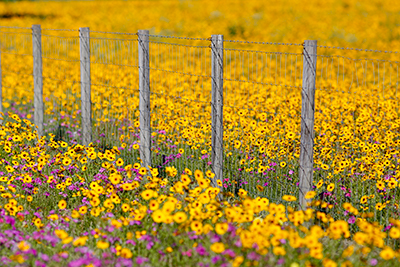
When in doubt, plant large patches of the same color or species. These mass plantings are easier for pollinators to spot and provide a more stable food source.
Credit: UF/IFAS
Florida’s native wildflowers will bring a kaleidoscope of colors and shapes to your landscape. They can take the heat, thrive in humidity, require little maintenance, and come back year after year.
Whether you’re trying to save the bees, support native wildlife, or just enjoy the sense of place that native plants offer, we’re here to help. Below are wildflower plant lists organized by bloom season; we encourage you to use them to add a little color to otherwise dull seasons in your landscape.
These lists are by no means comprehensive, and Florida is a big state. Many of the plants listed in this article may bloom for nine months in South Florida but only a few short weeks in the Panhandle. When in doubt, call your county Extension office. The Master Gardener volunteers and Extension staff are there to help!
Note: If Gardening Solutions does not have more information about a species listed below, the link will direct you to other UF/IFAS sources or to the UDSA Plant Database, and will open in a new window.
Winter Wildflowers (December – February)
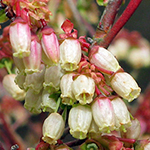
Flowers on a blueberry bush. Credit: Sandra Richard, CC BY-NC-SA 2.0
Winter in Florida is brief and mild; many of the plants that bloom between December and February will continue to flower well into Florida’s spring. These plants are of special importance to native pollinators, sustaining them when little else is in bloom. To make your yard a refuge in the lean months, choose butterweed (Packera glabella) or lyreleaf sage (Salvia lyrata). Gardeners in North and Central Florida can also add blue phlox (Phlox divaricata), Atamasco lily (Zephyranthes atamasca), and wild white indigo (Baptisia alba).
December is not high season for wildflowers, but shrubs, vines, and trees can also provide native wintertime blooms. Native blueberries, skyblue clustervine (Jacquemontia pentanthos), and flatwoods plum (Prunus umbellate) are good choices. More native and non-native options can be found in our article on Winter-flowering Trees and Shrubs.
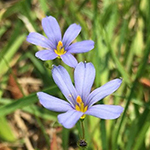
Blue-eyed grass. Credit: UF/IFAS
Spring Wildflowers (March – May)
Spring comes early to Florida and blooms follow the first warm rain. Common blue violet (Viola sororia), blue-eyed grass (Sisyrinchium atlanticum), and Florida greeneyes (Berlandiera subacaulis) peak in the spring throughout the state.
In North Florida, columbine (Aquilegia canadensis), green and gold (Chrysogonum virginianum), woodland pinkroot (Spigelia marilandica), and lupines (Lupinus villosus and L. perennis) are also flowering.
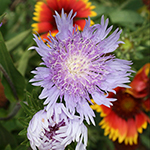
Stokes' aster with blanket flower blooming in the background. Credit: UF/IFAS
Spring to Summer Wildflowers
For spring blooms that will continue well into the summer months, look for Carolina wild petunia (Ruellia caroliniensis), lizard's-tail (Saururus cernuus), passion flower (Passiflora incarnata), pinewoods milkweed (Asclepias humistrata), oakleaf fleabane (Erigeron quercifolius), and spring lady’s tresses (Spiranthes vernalis).
North Florida is also home to golden ragwort (Packera aurea), soft greeneyes (Berlandiera pumila), Stokes' aster (Stokesia laevis), and Georgia tickseed (Coreopsis nudata).
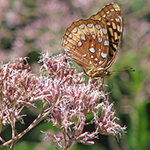
Great spangled fritillary in Joe-Pye weed. Credit: Vicki DeLoach
Summer Wildflowers (June – August)
Summer seems to last forever in the Sunshine State, but meteorological summer runs from June 1st to August 31st. During these hot months Bartram's rose gentian (Sabatia bartramii), beach sunflower (Helianthus debilis), narrowleaf yellowtops (Flaveria linearis), and oblongleaf twinflower (Dyschoriste oblongifolia) are at their best.
In North Florida purple coneflower (Echinacea purpurea) and turk's-cap lily (Lilium superbum) are also good choices. Central and South Florida can also enjoy blue porterweed (Stachytarpheta jamaicensis). Finally, North and Central Florida are home to Joe-Pye weed (Eupatorium fistulosum) and starry rosinweed (Silphium asteriscus).
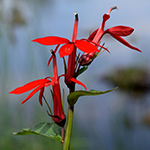
Cardinal flower.
Credit: John Munt.
Summer to Fall Wildflowers
For summer blooms that last through the fall, try coastalplain honeycombhead (Balduina angustifolia), giant ironweed (Vernonia gigantea), goldenrods (Solidago spp.), silk grass (Pityopsis graminifolia), Jacquemontia (Jacquemontia tamnifolia), Leavenworth's coreopsis (Coreopsis leavenworthii), partridge-pea (Chamaecrista fasciculata), bee balm (Monarda punctata), starrush (Rhynchospora colorata), or mistflower (Conoclinium coelestinum).
In North Florida and some parts of Central Florida, orange coneflower (Rudbeckia fulgida), cardinal flower (Lobelia cardinalis), lanceleaf coreopsis (Coreopsis lanceolata), and standing cypress (Ipomopsis rubra), are also found natively and in flower.
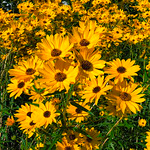
Swamp sunflower.
Credit: UF/IFAS
Fall Wildflowers (September – November)
In fall many turn their gardens into a paradise of autumn colors, but the heat is far from over. Native wildflowers for this season include rayless sunflower (Helianthus radula), slender blazing star (Liatris gracilis), and white crownbeard (Verbesina virginica).
North and Central Florida can also enjoy pinkscale blazing star (Liatris elegans), swamp sunflower (Helianthus angustifolius), and vanilla plant (Carphephorus odoratissimus).
Multi-season Wildflowers
For gardeners hoping to fill in the gaps between seasons, there are plenty of wildflowers that bloom throughout Florida’s long growing season. How long exactly each plant blooms will depend on your location but most listed below bloom for two or three seasons.
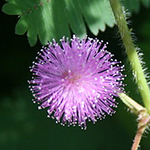
Powderpuff mimosa.
Credit: UF/IFAS
Some long-season wildflowers are well known, like black-eyed Susan (Rudbeckia hirta), blanket flower (Gaillardia pulchella), butterfly weed (Asclepias tuberosa), scarlet salvia (Salvia coccinea), pickerel weed (Pontederia cordata), and powderpuff mimosa (Mimosa strigillosa). Others are less common: bushy seaside oxeye (Borrichia frutescens), pale meadow beauty (Rhexia mariana), and winged loosestrife (Lythrum alatum). Gardeners in North and Central Florida might also enjoy grassleaf coneflower (Rudbeckia graminifolia) and bluestar (Amsonia ciliata).
Adding native plants to your garden
Native wildflowers can be difficult to find commercially, but the options are growing. Native plant nurseries carry many Florida favorites. Seed catalogues are expanding their selections as well. Don’t underestimate online seed-saver groups and generous neighbors as a source of native seed, either.
In general, plan to sow seed a couple of seasons before you expect blooms. October and November are good months to sow seed for summer-blooming wildflowers, for example. When in doubt, please contact the local experts at your county Extension office.
Also on Gardening Solutions
- Gardening for Bees
- Gardening for Butterflies
- Hummingbird Gardens
- Native Plants
- Parts of a Flower
- Wildflowers in the Garden
More from UF/IFAS
- Attracting Native Bees to Your Florida Landscape
- Butterfly Gardening in Florida
- Common Native Wildflowers of North Florida
- Native Plants: An Overview
- Native Wildflowers on Roadsides of Central and South Florida
- Performance of Native Florida Plants under North Florida Conditions

